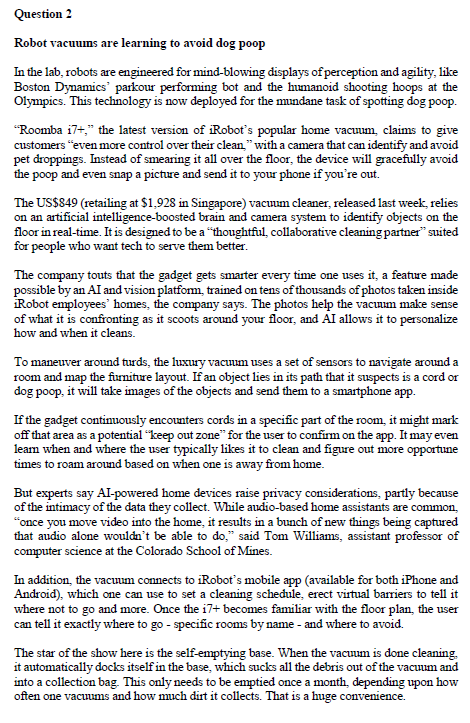Question
Question: (a) Based on the concept of customer perceived value (CPV), comment on whether the Roomba i7+ offers users high customer perceived value in terms

Question:
(a) Based on the concept of customer perceived value (CPV), comment on whether the Roomba i7+ offers users high customer perceived value in terms of both total customer benefit and total customer cost.
(b) Discuss the considerations involved with two (2) pricing methods that iRobot would have to grapple with, and explain which of the two methods discussed would be more appropriate for the Roomba i7+ vacuum cleaner.
For the pricing method, choose from the following pricing setting strategies: markup pricing, target-return pricing, perceived-value pricing, value pricing, going-rate pricing and auction type pricing.
(c) Demonstrate how you would employ one (1) mass communications tool and one (1) digital communications tool that the iRobot brand and the Roomba i7+ could implement to create- awareness and build product preference. Please provide sufficient elaboration and justification for the selected strategies.
You should suggest the most suitable and effective strategies among the following: advertising, sales promotion, events & experiences, public relations and online marketing, social media marketing, word-of-mouth and mobile marketing.
Question 2 Robot vacuums are learning to avoid dog poop In the lab, robots are engineered for mind-blowing displays of perception and agility, like Boston Dynamics' parkour performing bot and the humanoid shooting hoops at the Olympics. This technology is now deployed for the mundane task of spotting dog poop. "Roomba 17+," the latest version of iRobot's popular home vacuum, claims to give customers "even more control over their clean," with a camera that can identify and avoid pet droppings. Instead of smearing it all over the floor, the device will gracefully avoid the poop and even snap a picture and send it to your phone if you're out. The US$849 (retailing at $1,928 in Singapore) vacuum cleaner, released last week, relies on an artificial intelligence-boosted brain and camera system to identify objects on the floor in real-time. It is designed to be a "thoughtful, collaborative cleaning partner" suited for people who want tech to serve them better. The company touts that the gadget gets smarter every time one uses it, a feature made possible by an AI and vision platform, trained on tens of thousands of photos taken inside iRobot employees' homes, the company says. The photos help the vacuum make sense of what it is confronting as it scoots around your floor, and AI allows it to personalize how and when it cleans. To maneuver around turds, the luxury vacuum uses a set of sensors to navigate around a room and map the furniture layout. If an object lies in its path that it suspects is a cord or dog poop, it will take images of the objects and send them to a smartphone app. If the gadget continuously encounters cords in a specific part of the room, it might mark off that area as a potential "keep out zone" for the user to confirm on the app. It may even learn when and where the user typically likes it to clean and figure out more opportune times to roam around based on when one is away from home. But experts say AI-powered home devices raise privacy considerations, partly because of the intimacy of the data they collect. While audio-based home assistants are common, "once you move video into the home, it results in a bunch of new things being captured that audio alone wouldn't be able to do," said Tom Williams, assistant professor of computer science at the Colorado School of Mines. In addition, the vacuum connects to iRobot's mobile app (available for both iPhone and Android), which one can use to set a cleaning schedule, erect virtual barriers to tell it where not to go and more. Once the 17+ becomes familiar with the floor plan, the user can tell it exactly where to go - specific rooms by name - and where to avoid. The star of the show here is the self-emptying base. When the vacuum is done cleaning. it automatically docks itself in the base, which sucks all the debris out of the vacuum and into a collection bag. This only needs to be emptied once a month, depending upon how often one vacuums and how much dirt it collects. That is a huge convenience.
Step by Step Solution
There are 3 Steps involved in it
Step: 1
a Customer Perceived Value CPV The Roomba i7 offers high customer perceived value in terms of both total customer benefit and total customer cost The total customer benefit includes features like adva...
Get Instant Access to Expert-Tailored Solutions
See step-by-step solutions with expert insights and AI powered tools for academic success
Step: 2

Step: 3

Ace Your Homework with AI
Get the answers you need in no time with our AI-driven, step-by-step assistance
Get Started


